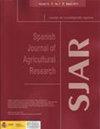有机质管理对番茄集约化温室土壤微生物群落活性和结构的影响
IF 0.8
4区 农林科学
Q3 AGRICULTURE, MULTIDISCIPLINARY
引用次数: 0
摘要
研究目的:集约农业影响土壤的物理、化学和生物特性;因此,向土壤中添加有机物(OM)对作物生产具有重要意义。本研究调查了三种作物管理系统对集约化温室农业中番茄生产和土壤微生物群落的影响。研究地区:阿尔梅里亚省(西班牙)。材料和方法:三种作物管理系统包括:(1)常规管理,使用合成化肥,不施用OM;(2) 常规管理,使用合成化肥,在过去三年中至少施用一次OM(CMOM);以及(3)全有机管理,每年施用OM,不使用合成化肥。主要结果:与CM土壤相比,在CMOM和ORG中添加OM会导致土壤NO3-和NH4+含量增加,进而增加氮的有效性,导致土壤呼吸增加。OM的加入也改变了原核和真菌土壤群落的组成。此外,OM的添加降低了潜在真菌病原生物的存在和丰度,如Sclerotinia sp.和Plectosphaerella cucumerina。与CM温室相比,在传统管理温室(CMOM)中添加OM可提高作物产量,总体产量增加880克/平方米。完全有机管理(ORG)下的产量最低,这可能是由于使用了营养和害虫管理方法。研究重点:我们的数据显示了有机物管理在集约温室系统中塑造微生物群落的重要性,这可能是发展更可持续的农业以养活不断增长的人口的关键因素。本文章由计算机程序翻译,如有差异,请以英文原文为准。
Influence of organic matter management on the activity and structure of soil microbial community in intensive tomato (Solanum lycopersicum L.) greenhouse farming
Aim of study: Intensive agriculture impacts physical, chemical, and biological characteristics of soil; therefore, the addition of organic matter (OM) to soil can have significant implications for crop production. This study investigated the impact of three crop management systems on tomato production and soil microbial communities in intensive greenhouse farming.
Area of study: Province of Almería (Spain).
Material and methods: The three crop management systems included: (1) conventional management, using synthetic chemical fertilizers without OM application (CM); (2) conventional management, using synthetic chemical fertilizers with at least one OM application in the last three years (CMOM); and (3) fully organic management, featuring yearly OM applications and no use of synthetic chemical fertilizers (ORG).
Main results: Compared to CM soils, OM addition in CMOM and ORG led to higher soil NO3- and NH4+ content, which in turn increased nitrogen (N) availability, leading to an increase in soil respiration. The addition of OM also altered the composition of prokaryotic and fungal soil communities. Besides, the addition of OM reduced the presence and abundance of potential fungal pathogenic organisms, like Sclerotinia sp. and Plectosphaerella cucumerina. OM addition to conventionally managed greenhouses (CMOM) led to higher crop yields compared to CM greenhouses, resulting in an overall increase of 880 g m-2. Production under fully organic management (ORG) was lowest, possibly due to the nutrient and pest management practices used.
Research highlights: Our data show the importance of organic matter management in shaping microbial communities in intensive greenhouse systems, which can be a key factor in developing a more sustainable agriculture to feed a growing human population.
求助全文
通过发布文献求助,成功后即可免费获取论文全文。
去求助
来源期刊

Spanish Journal of Agricultural Research
农林科学-农业综合
CiteScore
2.00
自引率
0.00%
发文量
60
审稿时长
6 months
期刊介绍:
The Spanish Journal of Agricultural Research (SJAR) is a quarterly international journal that accepts research articles, reviews and short communications of content related to agriculture. Research articles and short communications must report original work not previously published in any language and not under consideration for publication elsewhere.
The main aim of SJAR is to publish papers that report research findings on the following topics: agricultural economics; agricultural engineering; agricultural environment and ecology; animal breeding, genetics and reproduction; animal health and welfare; animal production; plant breeding, genetics and genetic resources; plant physiology; plant production (field and horticultural crops); plant protection; soil science; and water management.
 求助内容:
求助内容: 应助结果提醒方式:
应助结果提醒方式:


